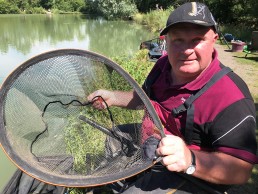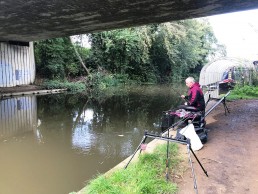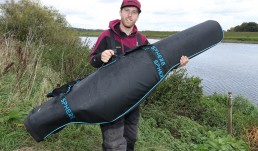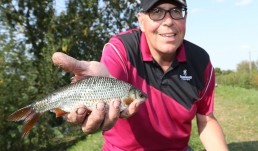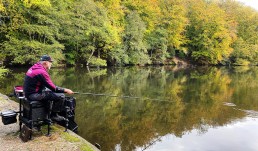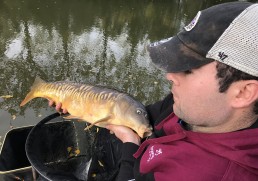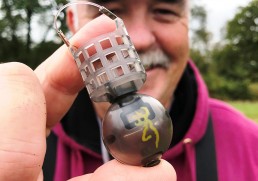No-Snag Latex Landing Nets
We all have favourite items of kit, ones that seem to last forever and just don’t let us down and one of mine is the No-Snag Latex Landing Net head. The reason is that over the years I’ve lost count of how many nets have let me down at the vital moment, either being too weak for the constant punishment they get from commercial match fishing, threads stripping or frames breaking however the area that seems to go first is the mesh. Standard mesh nets get damaged easily, be it from getting caught in a bank side snag, a hook snagging within, catching in the zip when closing a net bag, or more likely from a split dorsal fin of a carp whilst being unhooked. All these can cause a small tear in the mesh and once there, the landing nets days are numbered. Just constantly putting nets away in a net bag damp will eventually take its toll and over time weaken the mesh from rotting.
Mesh nets are a thing of the past for me and Latex mesh nets are here to stay as they take all the punishment thrown at them and simply brush them aside. Hooks and fins don’t get caught up, all saving vital seconds in a match and they don’t rot, the only minor disadvantage is that Latex nets are slightly heavier but for all the advantages they provide, I can live with this.
Available in three sizes –
L 50cm x W 38cm x D 28cm
L 60cm x W 48cm x D 30cm
L 60cm x W 48cm x D 35cm
Alec Roberts

These nets are very easy to manoeuvre.
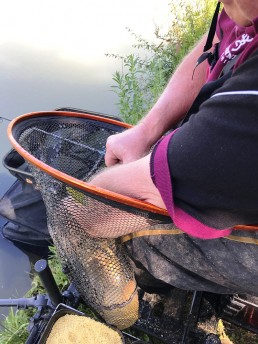
No chance of a fin ray getting caught.

I am a complete convert to these nets.
"The Latex mesh makes such a difference."
Catch Carp on the Deck
It’s getting to that time of the year when the carp start to spend more time close to the bottom and catching them hard on the bottom becomes a viable option. Today I am fishing Messingham Sands Fishery, where this is one of the key methods for the big carp that you need to catch to win here. Big catches are on the cards, with triple-figures easily achievable. These big super-strong carp will put a real strain on your gear, so it is important to get your tactics right to be in with a chance of winning.
Today I am fishing a peg just along the ‘spit’ in the centre of Island Lake. In front of me I have a large island, along with several snag bushes and beds of lilies. The margins are also lined with trees, so there are plenty of options to fish, but also lots of potential pitfalls, should a fish charge off towards cover. I have picked a couple of spots to fish, both of which are not too close to the cover. The fish here will respond to the sound of pellets peppering the surface when I feed, and drawing them away from danger gives me more chance of landing them.
I’m using the blue 2.3mm Xitan Microbore elastic rigged through the top-two kit of my Sphere Zero G PT+. This elastic is rated at 9-13, and with a puller kit is more than adequate for landing double-figure carp. My rigs are made up with 0.16mm Cenex Hybrid Power with a 15cm hooklength 0.14mm Hybrid Power. To this I am using a size 14 Sphere Beast barbless hook with a bait band tied in tight to the back of the hook. The swim is about six feet deep, and as I want to catch on the bottom I have plumbed up with the rig just on depth. A moveable bulk shotting sits just above the hooklength.
The wind is quite gusty down the lake today, so I am not going to try to fish too far out. Around 13 metres will be fine today, especially as there is no one on the adjacent pegs. I always try to fish as short as I can when the conditions are poor as this makes such a difference to your efficiency.
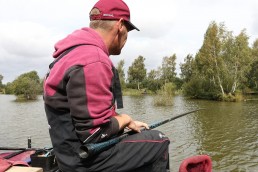
Fish slightly away from features to give yourself more time to control the first rush of a carp.

A lovely Messingham Sands carp.

Sphere Beast hooks are perfect for the job.
"The key to catching consistently here often comes down to feeding."
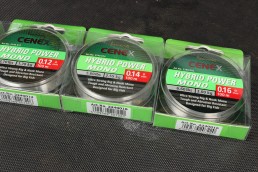
Don’t be tempted to fish too light. Aim to land every fish you hook.

The carp here are well known for fighting really hard.
The key to catching consistently here often comes down to feeding. The carp really respond to pellets going in, so I will feed half a dozen 8mm pellets every 30-seconds. If I start getting too many lines-bites though I will increase the number of pellets that I feed, but reduce the frequency a bit to ensure more of the bait gets to the bottom. You can easily spot most of the liners, as the float dithers and pulls sideways, rather than going under positively. Try to give the bites a second to develop so as not to foul-hook too many fish.
I am using quite big pellets both as feed and on the hook. This is a definite ‘edge’ on this lake, the carp do like a big bait. The other advantage is that silver fish, particularly skimmer bream, are a little less likely to pick up these big baits. I don’t mind catching silvers, but if you want to win then you need to make sure that you are getting through to the bigger carp.
I will have several swims on the go in a match and may switch to a longer line on the lead if the bites aren’t coming often enough on the pole. The carp definitely do come in waves though, probably as shoals of fish move through the peg. Don’t be in too much of a hurry to switch lines, as you may get two or three fish in quick succession after a bit of a wait, and that can put another 30-pounds in the net. Similarly, it can take the carp a while to gather in numbers at the start of your session. Keep feeding regularly and don’t stop. Eventually they will turn up and then it is game on!
There is no great secret to landing these powerful carp quickly. I like to ship back quite quickly and let the elastic do its work. Although the elastic is set quite firm, I can get back to the top-two kit quickly and then start to apply more pressure on the fish using the pulla kit. With a bit of luck, the carp will pop up right in front of the waiting net and I can scoop it before it really knows what is happening. Miss that first chance and you can often see the fight go on for two or three times longer! It might seem a small point, but this is why using a quality landing net handle, combined with a net that can be easily moved through the water is so important. Over five hours this can put several more fish in the net.
Time flies when catching carp on the pole. In many ways this is quite a simple tactic, but one where getting into a smooth rhythm makes all the difference. Pay particular attention to feeding and getting your gear correctly balanced and big catches can easily be on the cards.
Tight lines!
Jim Hall

Don’t be afraid to use a heavier rig if the wind picks up.

Keep those pellets going in on to keep the bites coming.
Jim’s Gear
Sphere Zero G PT+ Pole
Cenex Hybrid Power Line 0.16mm
Cenex Hybrid Power Line 0.14mm
Sphere Bead Barbless Hook
Medium Bait Bands
0.3 gram Float
Jim’s Bait
8mm Fishery Pellets
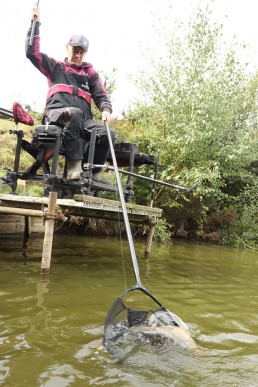
The Sphere Zero G PT+ pole is perfect for this job.
Catch Bonus Fish On Worms
Originally published in English.
We all have different approaches when it comes to the tactics we adopt and feel comfortable with when approaching a match or practice session on our chosen venue. Some are happy to build a weight of silvers and constantly feed a number of different lines, some are quite happy to target a certain species and some are happy to look for fewer but bigger fish.
Faith and Patience
I have to admit that I’m one of those anglers that like to target fewer but bigger fish and if there is a bait on the canals that will sort these out it has to be worm, a bait that very few species will ignore. Fortunately eels count in our friendly matches and are somewhat partial to a worm and with bream and perch on the cards as well, rarely will a few bonus fish grace my net and I’m happy to play the waiting game, be patient and have faith that although I may only be looking for three or four decent fish, if they are the ones I’m after then there’s a very good chance I will be looking at framing, if not winning.
One of my local venues is The Wey Navigation Canal and over the years this approach has served me well here. Today I’ve decided to steer clear of the noted big fish swims, the reason being is that I feel I learn so much more simply dropping into a swim that I haven’t fished before and then having faith that my tried-and-tested approach will deliver any sizable fish within.

Worm and caster, a winning combination.
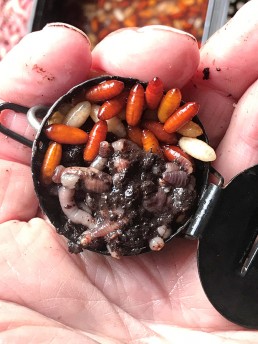
Baiting up with a dropper for pin point accuracy.
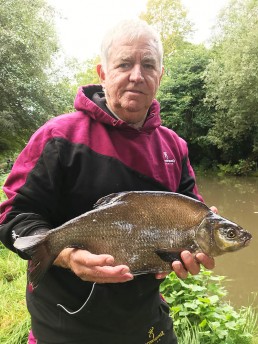
I’ll take a couple of these any day.
"Worms will often produce bigger bonus fish"
Rotating the two
The swim is certainly a feature swim being directly under a road bridge, definitely an area to look at as the winter sets in and quite often a hotspot for perch, however I don’t think that even the shade will have any effect on the fishing today as the canal is unusually coloured. I’m going to approach today’s practice session in my normal manner and feed to spots, both on the same line at two thirds of the way across which is around nine metres. The first line is slightly upstream of straight out; 11am lets say and the other at 1pm, slightly downstream. To kick start each spot I’m going to introduce one Bait dropper full of chopped worm and casters. The reason for a bait dropper is it gives me pin-point accuracy every time, especially when I line the pole up to a far bank marker. Each spot will be rotated and topped up at regular intervals throughout the sessions with a further half a dropper of worm and casters, even if they are showing no signs of fish. Another key time to top up is if a couple of fish are caught or bites missed before going quiet. Hookbait will mostly be half a worm and a caster cocktail, but every now and again will try a small piece of worm or caster on their own, even a couple of maggots, but never will I introduce maggots to the swim in the bait dropper as this attracts too many small fish.
A real all-rounder
I’m using a Sphere Zero-G Power Partner, a real all-rounder with Pink 1.9mm Microbore elastic through the top kit which is more than adequate even if a sizeable eel gets hooked. My rig consists of Cenex 0.18mm Hybrid Power mono onto which I attach a 1.25g rugby ball shaped wire stem float for stability, which will be over shotted and held back in position. The float is shotted with a bulk of fifteen no9 fifteen inches from the hook which is a size 16 barbed Sphere Match attached to 0.15mm Cenex Fluoro Carbon hook length. Two additional number nine shot are added to the hook length along with a tiny number twelve swivel that sits on the deck and also makes changing hook lengths easier.
Today’s three hour session has gone to plan in that I have put together around 8lb of fish, however with the added colour in the canal I would have put money on it, that eels would have played a major part in my catch but amazingly not one has shown. Instead my weight has been made up of three decent bream, plus a few small perch, roach and gudgeon, more than enough to frame in one of our matches.
John Brownlie
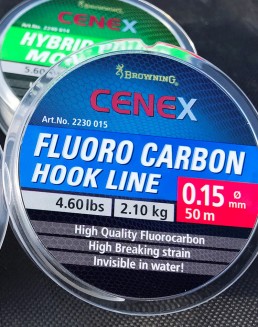
Fluoro Carbon hooklink, a massive edge.
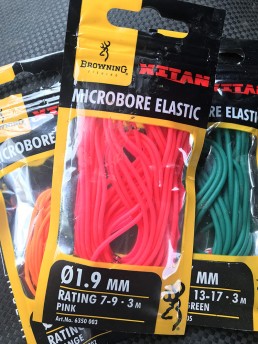
1.9mm Microbore, will handle anything hooked today.

Not what I expected but I’ll take a catch like this any day.
John’s Tackle
Sphere Zero-G Power Partner
Size 16 Sphere Match Hooks
Cenex 0.18mm Hybrid Mono
Cenex 0.15mm Fluoro Carbon Hook Line
1.25g Float
Xitan Microbore Pink 01.9mm Pole Elastic

Sphere Match hooks, sharp and reliable.
Sphere Multi Rod Carrier
I will often have several feeder rods with me when fishing the river Trent to cover all eventualities, so I was on the look-out for a new holdall that would allow me to carry multiple made-up rods safely and securely. After a few months of use I can report that the Sphere Multi Rod Carrier has filled this role superbly, enabling me to keep all my feeder rods organised and ready to go.
Like all of the Sphere luggage range, the finish is superb. Made from the iconic woven carbon-effect fabric, which is not only really durable, but wipe clean as well – perfect for those muddy winter banks. All of the fittings, and particularly the zips, are really strong and will gives years of service, as you would expect from a Sphere product.
Inside, the dividers enable four made-up rods to be carried with plenty of room to spare. In fact, you can easily sneak in another rod if you need to, or a couple of spare rods in their bags. Whilst this isn’t a compact bag, the size does mean that you can carry everything, including the kitchen sink!
The semi-rigid design is well padded and gives excellent protection to my expensive feeder rods. There is even an internal pocket especially for spare tips, which is a really nice touch.
Whilst luggage like this is likely to spend most of its life on the barrow, the quality shoulder strap and carry handles have proven invaluable when there is the odd fence, or even steep banks, to negotiate.
If you want to carry your made up rods in total security then you really need to check this bag out at your local Browning stockist.
Tom Noton
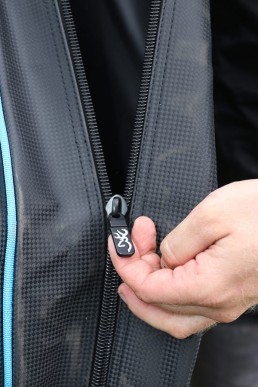
All of the fittings are top class.

The shoulder strap is useful for natural venues.

Each compartment can hold two made-up rods.
"Like all of the Sphere luggage range, the finish is superb."
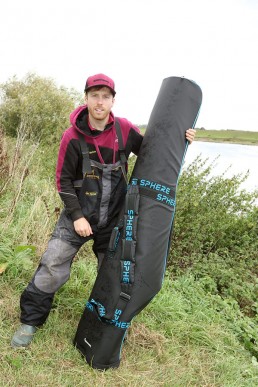
The bag is available in sizes to fit all feeder and float rods.

The reinforced base is a nice touch.
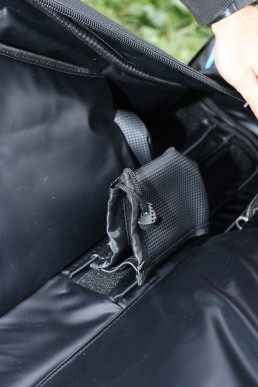
Internal pockets hold the rods securely.
Catch Silverfish on a Large Lowland River
Originally published in English.
Today we are fishing a practise session on the river Great Ouse near Ely in Cambridgeshire. This is a pretty typical area of this big lowland river, which can respond to a number of different tactics. Today our job is to each fish a different tactic and see how the fish respond. Obviously, come match day, things can be very different, especially with the extra pressure more anglers puts on the venue, but this is a good opportunity for us to make some tweaks to our tactics and get it right on match day.
My job today is to concentrate on the pole line, trying to put together a net of silvers, and perhaps snare a bonus fish or two. I will also bait up a couple of other lines, more for the better, bonus fish, but let’s stick to talking about the pole line.
The river here is around 50 metres wide, with a distinct channel beyond the marginal shelf. Fortunately, there is a good depth at around eight metres, and the bottom is pretty level once we go beyond the ten metre mark, meaning I don’t need to fish too far out. This also gives me the opportunity to bait a couple of different lines at the start and, with a bit of luck, draw the fish in closer as the day progresses where I can catch them faster.
My opening gambit is to introduce six good-sized balls of groundbait at around 11 metres. This is a combination of Champion’s Feeder Black Roach and Champion’s Choice Canal. Into this I have put some dead pinkies, chopped worm and casters and have moulded the balls quite firmly, the aim to get them on the bottom before they break up. There are quite a lot of bleak and tiny rudd here, so I need my bait (and rig) to get down fast to avoid these.
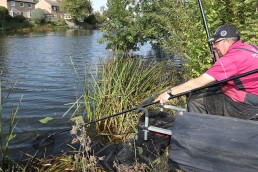
Expect plenty of ’net‘ roach here.
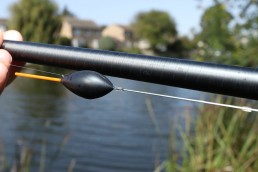
I like a stable float because it gives more control on a typical windy day.
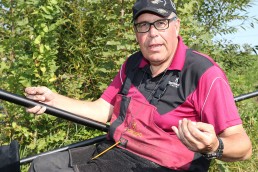
Use an olivette about 60cm from the hook to get the bait through the bleak that lurk near the surface.
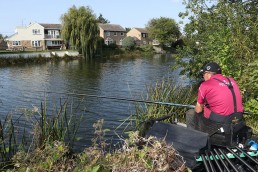
The river channel is at a comfortable distance, giving me room to follow the fish out.
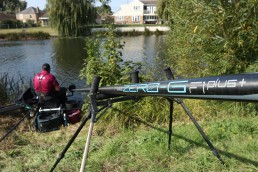
I use the awesome Sphere Zero G PT+ Pole.
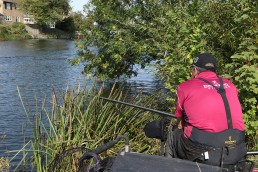
My bonus fish line under this overhanging tree didn’t produce today.
"I want to have a nice concentrated area of bait that hopefully will draw the fish in."
I want to have a nice concentrated area of bait that hopefully will draw the fish in. These will probably mainly be roach, with a few rudd, skimmers and maybe a bonus fish thrown in for good measure.
As roach are my main target I will regularly feed a little hemp over the top of the groundbait. Hemp is less likely to bring the bleak in, and sinks quickly, so hopefully it will keep the roach interested. I will try hemp later in the day as if the roach switch on to it then I can expect a better stamp of fish on this hookbait.
If the bites slow down and I feel that the roach are drifting away I will top up the line with two more balls of groundbait, I’ll also play with what amounts of particles I add too as this can affect the stamp and catch rate. It can also be a good idea it rest a line for a while after topping up giving fish the chance to re-group and remain confident. In this way, I hope to ring out as many fish as I can over the space of five hours. With a second line at the same distance, plus a shorter hemp and caster line just for roach, I can mix it up and hopefully keep catching.
The swim is about ten feet deep, and I expect to catch the bulk of the fish hard on the bottom, so I have set up a positive rig that will get the bait down quickly. Also, the wind here tends to blow either up or down the river, so a reasonably heavy rig gives me much better control. I’m using a two gram float with a bulk olivette about two feet from the hook, and then three no.10 shot evenly spaced below this. The bulk will get the rig down quickly but the smallish droppers provide a slower fall in the killing zone – I can also bunch these up for an even more positive rig if it gets really good. I expect bites either in that bottom two feet as the float settles (or doesn’t), and then as I carefully work the rig once it has settled.
My rigs are made up on the excellent 0.12mm Cenex Classic Mono with a hooklength of 0.08mm diameter of the same to a size 19 hook. Light lines always mean more bites, but with skimmers bream and even the odd tench about 0.08mm will give me a chance without affecting my roach fishing.
It is a pretty typical Fenland day today. The wind is quite gusty downstream and the water quite clear. Even so, the bites have kept coming, only slowing down towards the end of the session. As expected, it has been a nice mix of fish, mainly roach, with the odd nice perch mixed in too. I did try a worm line for a better perch, or even a tench, but this has drawn a blank today. Oh well, next time!
It has been a really enjoyable and busy day. We have all learnt a few nuggets that will hopefully see us in good stead come our team match in a couple of weeks time on this venue. It has been interesting to see how the different tactics perform, with the pole line doing well.
Andrew ‘Mossy’ Moss

Rig control is important on a deep, windswept venue like this.

An initial bed of groundbait helps concentrate the fish. Top up if the bites slow down.
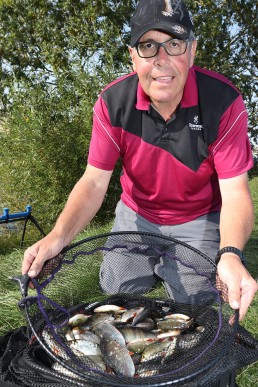
It has been an interesting and productive session.
Mossy’s Gear
Sphere Zero G F1+ Pole
Cenex Classic Line 0.12mm and 0.08mm
Size 19 hook
2 gram wire stemmed float
Olivette bulk with three no. 10 droppers
Mossy’s Bait
Champion’s Feeder Black Roach
Champion’s Choice Canal
Pinkies
Maggots
Worm
Hemp
Caster
Sphere Silverlite System Whip
Original article in English.
The Sphere Silverlite System Whip really does raise the roof when it comes to speed fishing for silver to hand. This has to be the most versatile whip system on the market and makes fishing to-hand at longer lengths and short-line speed fishing, at long lengths, all the way up to 10m effortless.
I recently put this mixed tele/takeapart System Whip through its paces, first taking it to a deep clear venue where I fished the flicktip at 8m to hand. It’s incredibly slim, ultra light and amazingly durable as it’s been built using the same respected Sphere grade carbon and build technology creating that middle section stiffness needed when fishing to hand. Balanced and responsive simply means more bites hit and more fish in the keepnet come the end of the day, exactly what all experienced, professional match anglers demand.
The second trial was on a totally different venue, very shallow where every so often between the silvers a carp or big bream could barge in on the action. Elasticating a top two sections the inevitable soon happen and elastic stretched from the tip but as I have come to expect having used other Sphere poles for years, there was no need to worry as I soon had the first carp under control and in the net.
The Sphere Silverlite System Whip is available in two sets, 10m and 8m which is what I have and this comes complete with 8m pole (3-section telescopic topkit, plus 5 take apart sections) including flicktip, reversible Pole Protector to fit 7m and 8m sections, 2 x 3/1 telescopic top kits with hollow tips* plus its Hardcase Multi-pocket carry case.
This system also boosts an array of innovative features and technology such as Strengthened Stress Points, Diamond Surface Finish for smooth and fast shipping, Section Alignment Points for maximum stiffness, Pole Protection System plus many more.
Ever since picking up the new Sphere Silverlite System Whip I just can’t put it down and know this pole is going to give me a genuine performance advantage.
Justin Watkins
*Note – both top kit types can be converted to hollow or solid flick tip type by changing the tip “A” section only – the tips are available as spare parts.
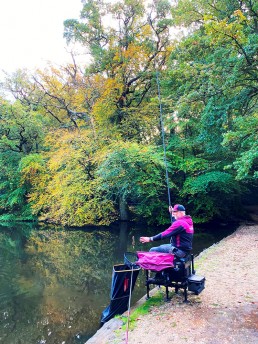
Silvers to hand – I love it!
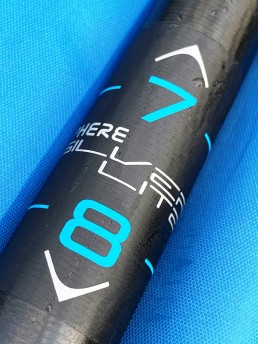
Striking graphics for easy recognition.
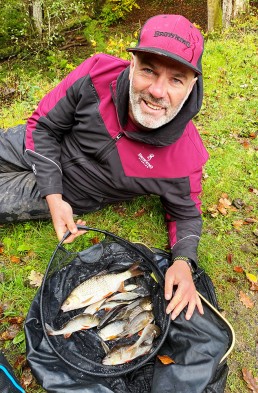
The end result of a quick-fire session.
"this pole is going to give me a genuine performance advantage"

Supplied in its very own special hardshell carry case.

Over-wrapped grip areas for added strength.
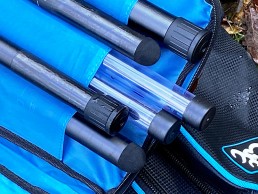
The internal pockets in the hard case enable me to organise my top kits.

Highest quality Japanese carbon with internal reinforcing.
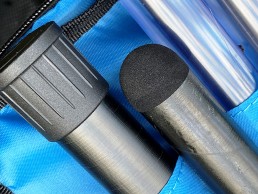
Section protection comes as standard.

I love the understated graphics.
Big Pit Mini Feeder
Original article in English.
One of my favourite feeders in the Browning range is the Big Pit Mini. This diminutive version of the standard Big Pit Feeder is my go-to on venues where I need to recast regularly, often catching fish on the drop, or when I want to limit the amount of bait that I am introducing. This is particularly important when fishing for silvers, where overfeeding can be a problem with many larger feeder designs. If I’m fishing drains, big wide canals and short chuck on a lake, these are my go to feeder!
The reduced size of the Big Pit Mini allows me to feed a pinch of free-offerings compressed between two plugs of groundbait. Enough to keep the fish interested and no more. Although the feeder has a really open configuration, with much larger holes than many similar designs, the internal ridge hold groundbait really well. This ensures that you can punch these feeders out on the cast, when faced with a stiff cross wind, for example, without losing the contents – this is even the case with really dry mixes.
A lot of the venues that I fish are between 30 and 60 metres wide, so the 15 gram to 30 gram loading on these small feeders is perfect. Coupled with Cenex Feeder Braid and my Sphere Braid Special feeder rod they really fly accurately.
The moulded plastic construction have proven to be very reliable and doesn’t not suffer from the brittleness sometimes seen in other feeders. The short stem and moulded in swivel produces a strong and tangle-free design.
If you regularly target silverfish on slow-flowing rivers, drains or stillwaters, or perhaps want to introduce a snack-sized helping of sticky pellets for carp, then I can thoroughly recommend you give these feeders a go.
Dimensions 24mm long by 25mm in diameter.
Size 15 grams, 20 grams, 25 grams, 30 grams.
Kye Jerrom
Browning HotRods

This is the perfect compact feeder.
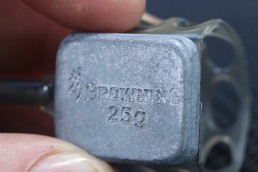
Four different weights are available, covering most conditions.

The weights are very well secured, follow the shape of the body reducing tangles.

The swivel is securely moulded into the stem.
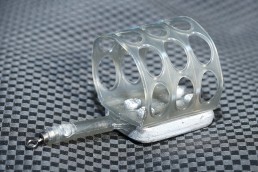
The perfect size for introducing a small amount of bait.
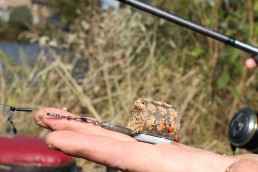
Plug the ends of the feeder with groundbait to hold the content in place.
"Ideal for both natural and commercial venues."
Bright Baits for Cold Carp
With the water temperature cooling, carp tend to shoal tightly, find them, drip feed them and then if you approach them in a stealthy manner you should catch them. Today I’ve headed to one of my favourite fisheries, Rolf’s in Oxfordshire, one I have fished extensively for years and if I’m right a fair share of the carp will be keeping warm, tight in a corner where a big lily bed is dying away. I could target this from a swim to the side but I need to get tight to the pads and with carp to well over 20lb possible its far better to attack the swim from the opposite bank, which is exactly where I’m heading.
Drip feeding
To get the carp in a feeding mood I’m going to drip feed four of five 8mm fishery own, slow sinking pellets every thirty seconds right next to the lilies. This I will do whilst setting up and if all goes to plan when I make my first cast in around half an hour there should be a few competing for these.

After feeding for half an hour, it was a carp a cast.

Bright critically balanced baits, just irresistible.
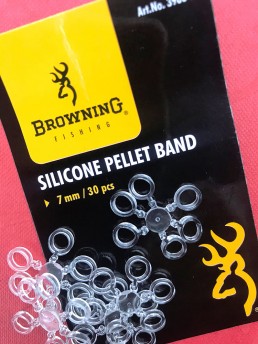
Pellet Bands – quick and easy.
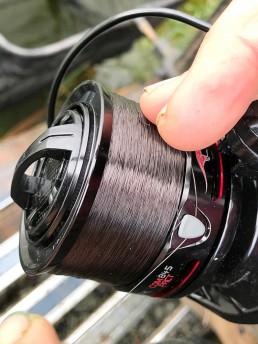
Clipped up at all times, just don’t switch off.
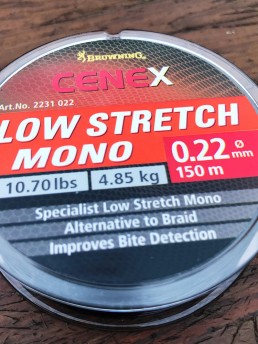
Cenex Low stretch Mono, great for bite detection.

Cenex Hybrid Power Mono for super supple, strong and tough hook lengths.
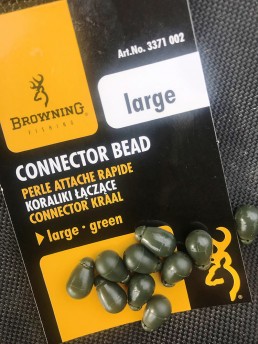
Soft, easy part and reliable Connector Beads.
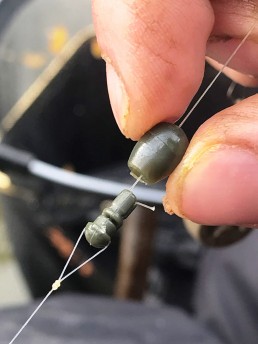
Connector Beads, simple to use.
"the power of the rod will see the carp kitting and heading into open water."
Simple but powerful
Tackle for carp this big needs to be robust but balanced so I’ve opted for my Sphere Bomb rod but the version with 10% extra power. This rod is unbelievable and has been created from the highest quality carbon blank and fittings available to produce an ultra light, ultra slim rod that just makes you want to catch fish after fish. It has a soft action which allows light lines and small hooks to be used when needed, however the power in the butt section is amazing and couple this with the action is something big carp just can’t deal with. This is teamed up with a Black Viper Compact 845 reel loaded with Cenex 0.20mm Low Stretch Mono which has an incredible breaking strain of over 8lb for its fine diameter and is also extremely abrasion resistant which is required if a carp manages to skirt the outside of the pads. On the business end things are kept relatively simple with a 1oz lead placed on a Quick Change Swivel which runs on the mainline and is buffeted by a Connector Bead. The hook length, which is around fifteen inches is created from Cenex 0.18mm Hybrid Power Mono, again very abrasion resistant but also very supple, and has a Sphere size 14 barbless hook attached knotless knot style with a hair containing a 7mm Silicone Bait Band.
Slow sinking
Hookbait is simple, an 8mm bright pink wafter that I’ve checked in the margin before casting, as I want it to sink really slowly, just like the freebies that I have been catapulting around.
A repeat performance
The last thing I need is for a carp to dive into the roots of the lily bed so although I’m casting tight to these I’m also clipping up as this will avoid disaster happening. The bend in the rod and minimal stretch in the line will give me a couple of feet to put the brakes on when the rod pulls round, and guess what it’s done this almost immediately. It’s really important when fishing clipped up to place the rod across your knee and only have a small angle from rod tip to bait. As soon as it pulls round the power of the rod will see the carp kitting and heading into open water. The first carp is a beautiful fully scaled mirror around 6lb but I have had them, on similar tactic to over 25lb in the past here so expect a proper chunk to turn up at anytime. It looks like it’s going to be an eventful day as the next cast see’s a repeat performance, yet this one is more of the average size you can expect from Rolf’s, a low double. Now for that twenty!
Michael Colsino
Michael’s Tackle
Sphere Bomb + 10% Power
Black Viper Compact 845
Cenex 0.20mm Low Stretch Mono
Cenex 0.18mm Hybrid Power Mono
Sphere size 14 barbless Beast Hook
Connector Bead
7mm Silicone Bait Band
Quick Change Swivel
1oz Lead
Michael’s Bait
8mm Pink Wafter
8mm low oil fishery own pellets
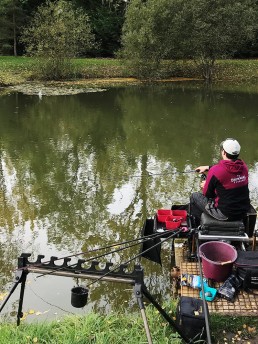
Perfect touchdown next to the dying pads.
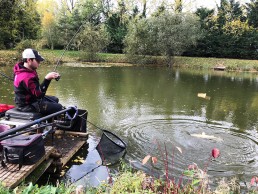
Rolf’s is famous for its big carp.
Cenex Sinking Feeder Braid
One of the most significant innovations in modern feeder fishing has to be the development of fine diameter sinking braids. These have been a revelation for the feeder angler, not only allowing us to use finer main lines than before, but also giving much better bite indication than was previously possible, and all in a line that does not deteriorate over time.
My choice for most of my feeder fishing is Cenex Sinking Feeder Braid in 0.10mm diameter, which has a breaking strain of 12lb. When you compare this to a traditional nylon mono line of the same breaking strain, which has a diameter of roughly 0.32mm, you can see just how big the margins can be.
Not all fine braids are created equally though. There are several factors to take into account when choosing a braid. One of the most important is that the braid should have a round profile. This is not so easy to achieve in fine braids, but the Cenex braid ticks all the boxes in this respect, and loads onto the reel very well indeed.
A round braid creates much less water resistance than one with a flat profile, allowing me to use much lighter feeders, and giving better bite indication. Line twist and the dreaded bedding-in, which can effect casting distance and accuracy, are not a problem with this line.
Another problem with some fine braids is that they float and are difficult to cut through the surface film of the water. This is especially important when fishing at long range and in a cross-wind, when you need to get the line down quickly to stop a bow from forming. As the name suggest, this braid really does sink very well.
Knotting a fine braid to a thicker shock leader can cause a weak spot, but I have found this not to be the case with my chosen combination. The knot is neat and runs through the rod rings easily, without catching. It is also remarkably strong and has not let me down.
A minor point, but some braids can quickly lose their colour when exposed to water and sunlight. The Cenex braid tends to hold its dark green colour very well has hardly changed even after several months of hard use.
I tend to use braid with a shockleader of 8lb Black Magic Gold Mono. By using a slightly weaker leader if I should snag the feeder (which is pretty rare), then the leader will break before the braid, meaning I lose minimal gear.
If you haven’t yet made the switch to braided main lines for feeder fishing, or perhaps you are looking for a reliable line, then I can whole heartedly recommend Cenex Sinking Feeder Braid. Once you try it there is no going back!
Tight Lines!
Tom Noton
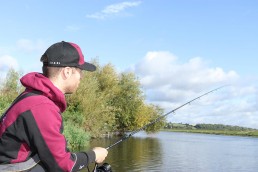
Braid enables me to fish with lighter feeders and magnifies bites.
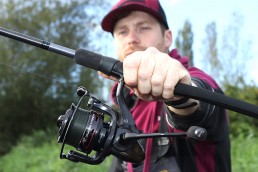
The perfect braid for my feeder fishing.

Brilliant line-lay and a long-lasting dark green colour.
"I can whole heartedly recommend Cenex Sinking Feeder Braid."
Xenos J-25 Slow Sinking Feeder
This innovative feeder has given me a major edge in many a match allowing me to catch carp from the off, leaving others anglers around playing the catch up game.
Before revealing my edge let’s take a quick look at the Xenos Feeders which come in three sizes (J-25, J-28 and J-32) and have weighted heads at the front ranging from 30-80g which can be easily removed and altered. Whether you want to deliver a small payload a long way out or a big pay load in close, these feeders are extremely versatile and cover most situations, but there’s also a floating ball shaped head that fits these feeders that not only allows carp to be caught off the top but more importantly can be adjusted to sink at different speeds catching them from every depth within the swim.
To make this floating head sink all you do is to remove the plug from the small hole within and add split shot. The more you add, the quicker it sinks but the most deadly decent I have found is to critically balance it so it sinks mega slow, just like the pellets placed within the cage and the one next to your hook.
I know it all sounds too good to be true, in fact many will be saying ‘that won’t work’ but until you have tried this you just won’t be aware of what you’re missing out on.
Colin Sheppard
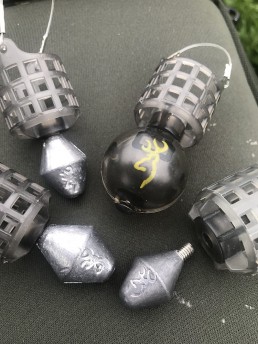
Fully interchangeable feeders.

Adding weight will adjust the speed the feeder falls through the water.
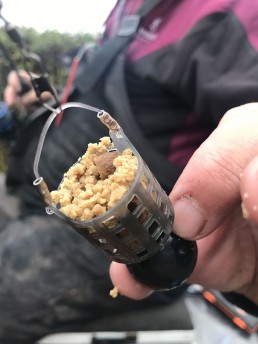
Fully loaded and ready to go.
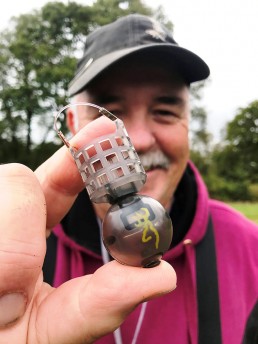
My secret weapon, revealed!
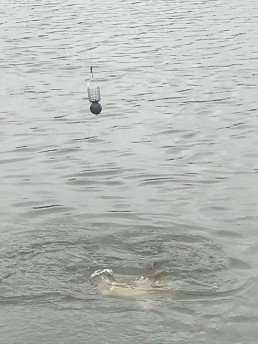
Catching while other around struggle.
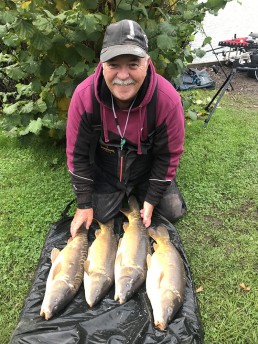
If you have a deep commercial full of carp nearby, you really need to get on the Slow Sinker!
